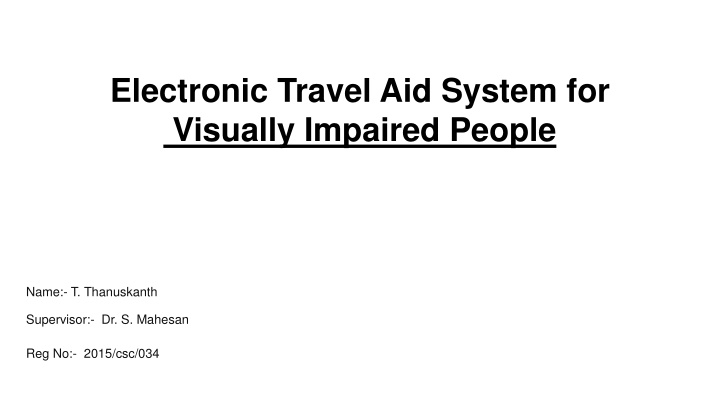
Electronic Travel Aid System for Visually Impaired: Innovative Solution by T. Thanuskanth
This project by T. Thanuskanth, supervised by Dr. S. Mahesan, focuses on developing an Electronic Travel Aid System to assist visually impaired individuals in navigating public spaces. The system utilizes image processing and distance sensing to detect obstacles and provide guidance to the user for safe navigation, overcoming challenges faced by traditional walking sticks. By identifying obstacle classes and offering directional suggestions, this innovative system aims to enhance independence and safety for visually impaired individuals. Explore the project's evolution, related works, and future possibilities in aiding the visually impaired.
Download Presentation

Please find below an Image/Link to download the presentation.
The content on the website is provided AS IS for your information and personal use only. It may not be sold, licensed, or shared on other websites without obtaining consent from the author. If you encounter any issues during the download, it is possible that the publisher has removed the file from their server.
You are allowed to download the files provided on this website for personal or commercial use, subject to the condition that they are used lawfully. All files are the property of their respective owners.
The content on the website is provided AS IS for your information and personal use only. It may not be sold, licensed, or shared on other websites without obtaining consent from the author.
E N D
Presentation Transcript
Electronic Travel Aid System for Visually Impaired People Name:- T. Thanuskanth Supervisor:- Dr. S. Mahesan Reg No:- 2015/csc/034
Problem Visually impaired people face unique challenges in their day to day life while navigating in unfamiliar public locations. Using a walking stick relies on trial and error, particularly in unfamiliar locations. Also from a walking stick the user can only identify obstacles which are touching the stick and cannot identify the obstacles which are above his waist height.
An Earlier System. This ETA system grants the user the ability to travel independently with an automated alerting system designed for emergencies. The obstacles are detected using image processing and distance sensing through IR sensors. A navigation system was developed to assist the user via web access
My Project.. It will identify the classes of the obstacles It will guide the user by giving suggestions on the directions of making his next move safe
RELATED WORKS P. S. Ranaweera, S. H. R. Madhuranga, H. F. A. S. Fonseka and D. M. L. D. Karunathilaka, "Electronic travel aid system for visually impaired people," 2017 5th International Conference on Information and Communication Technology (ICoIC7), Malacca City, 2017, pp. 1-6. R. Bhambare, A. Koul, S. Bilal and S. Pandey, Smart Vision System for Blind , International Journal of Engineering and Computer Science, vol. 3, no. 5, pp. 5790- 5795, May 2014. D. Dakopoulos and N. Bourbakis, Wearable Obstacle Avoidance Electronic Travel Aids for Blind: A Survey , IEEE Transactions on Systems, Man and Cybernetics - Part C : Applications and Reviews, vol. 40, no. 1, pp. 25-35, 2010.
